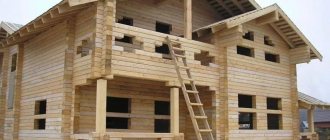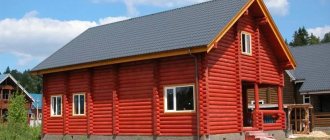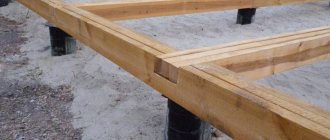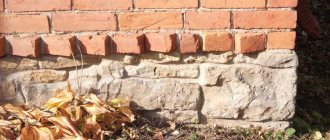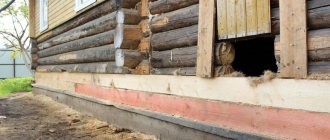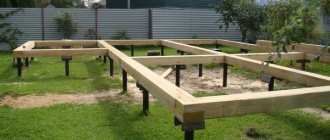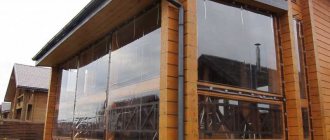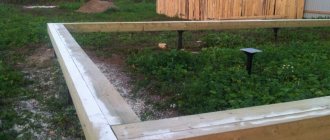Wooden houses are environmentally friendly and beautiful. In addition, subject to the technology of laying logs and appropriate processing of wood, they are also quite durable. The foundation is the basis for any structure, a wooden house is no exception. The wrong choice of base will lead to the formation of cracks, uneven shrinkage of the house, the appearance of gaps between the logs and even the complete destruction of the building. To decide which foundations for log houses you should best know the type of soil and the characteristics of the future structure.
Log house
When building a house from logs, the following types of foundations are mainly used:
- pile-screw;
- columnar;
- tape;
- monolithic;
- block
Each of them has its pros and cons. To understand which foundation is better, you should evaluate their characteristics and installation methods.
Monolithic foundation
Monolithic base
This type of base is a monolithic reinforced concrete slab and is the most expensive. Due to the fact that it follows the seasonal movement of the soil, it is called “floating”. Because of this, it is applicable to almost all structures, regardless of the type of soil and is able to withstand any load. However, before starting construction work, you should determine the groundwater level, the planned weight of the house and the type of soil.
- The construction of the foundation begins with clearing the site and digging a shallow pit (about 20-30 cm).
- Gravel and sand (10-20 cm high) are placed in the resulting depression, watered and thoroughly compacted.
- Waterproofing is laid on the prepared base to protect the slab from moisture.
- Then the formwork is installed.
- Next comes the installation of a frame made of steel rods. Basically, two layers of reinforcing mesh with a rod thickness of 12-16 mm are used. All this is held together with wire. The ends are insulated.
- After this, they begin pouring the concrete mass. The foundation for a log house is poured in one stage, otherwise its strength may suffer. The concrete is evenly distributed between the reinforcing bars. It will gain its strength within 1.5 months from the moment of pouring.
The grade of cement must be at least M300. The thickness of the slab depends on the building design. To build a house from logs, a slab up to 300 mm thick is required.
Sometimes inexperienced builders use a different type of foundation to build extensions. This is fundamentally wrong. It is strictly not recommended to combine a monolithic base with other types. Seasonal soil movement will cause the foundation for the log house to shift, and if there is a different type of foundation under the extension, then the ground movements will lead to a skew of its roof.
Factors to consider when choosing
- When determining the depth, first of all, it is necessary to take into account the type of soil on the site. For this, a geotechnician is involved, who conducts a study of the site and makes a verdict, on the basis of which recommendations are made.
Depth of bookmarks.
- Shallow foundations can be laid on compact, stable soils. Porous, marshy and sandy soils, as well as quicksand, require deep embedding or slab pouring.
- The next important factor is the level of frost penetration into the soil. As a rule, in this case there is no need to conduct field studies; it is enough to use average data for the region. But in any case, it is recommended to lay strip and pile structures at a depth of more than 200 mm from the maximum freezing depth.
- The enemy of all buildings without exception is the so-called frost splash. As you know, when water freezes, it expands and can push even strong structures out of the ground. To minimize this effect, the posts and straps can be arranged in a trapezoidal shape, where the cone runs from bottom to top.
Types of strip foundations.
- Nearby groundwater can not only undermine the foundation, but also destroy the concrete monolith. Therefore, experts recommend waterproofing structures and using concrete that is resistant to constant exposure to moisture.
- With the exception of auger piles, all other types of foundations must be mature before construction begins. Ideally, the structure should winter or stand for at least 6 months. The point is that the foundation will naturally shrink and you should let it finish before you start building your log home. Otherwise, cracks and distortions will appear.
Mixed design option.
The video in this article gathers more information on the topic.
Shallow or non-buried foundation
This type of foundation is built on gravel, sand and other drainage materials and is suitable for undulating soils with high groundwater levels. In this case, part of the soil around the foundation is replaced with a cushion, and the foundation itself is built above the ground level or buried at a very small depth - 0.4-0.5 m. Can be used for log and wooden houses.
Columnar foundation
Columnar base
This base option is the most economical. It cannot be used on heaving, unstable soils. Suitable for building houses on surfaces with plane differences of no more than 2 meters.
A columnar foundation for a log house is mainly used for light frame buildings or verandas. The pillars are made of brick, wood, asbestos pipes, concrete, stone or reinforced concrete. You can purchase ready-made concrete blocks. They are located in the corners of the building with an interval of 1.5-2.5 meters. And also under frame racks and at the intersections of walls.
Before constructing such a foundation, the depth of soil freezing should be determined.
The laying of pillars depends on this. Depending on the depth of freezing, it will be 10-30 cm. The depressions are filled with crushed stone and formwork is installed. Polyethylene or roofing felt is used as waterproofing. When properly installed, a columnar foundation for a log house is resistant to any frost.
Optimal foundation: costs for further operation
When choosing a foundation for a log house, we are guided by a number of criteria:
- compliance with load-bearing capacities;
- life time;
- material costs;
- complexity of installation;
- operating costs.
A foundation that meets standard standards does not require special maintenance during the operational period. It is only necessary to monitor the condition of the blind area, promptly clear the area of snow and overgrowth, and limit excavation work near the house. If, during the laying of the foundation, calculation errors were made and a set of waterproofing and insulation work was not completed, then negative consequences are possible in the form of cracking of concrete, the appearance of mold and mildew on the floor and walls. Taking this into account, we can summarize that the costs of a high-quality foundation pay off during the operational period.
Strip foundation
Strip foundation
A strip foundation for a log house is suitable for sandy, sandy-rocky or gravel soil types. To build such a foundation you do not need a large pit. The laying depth for central Russia on non-heaving soils should be 60-80 cm, and on heaving soils - about 1.5 meters. The width of the tape is slightly larger than the width of the wall and is about 30-40 cm.
A strip foundation is made along a closed contour.
- To do this, markings with ropes are made along the entire perimeter of the site according to the project.
- The top layer of soil is removed and a trench about half a meter deep is dug. When groundwater is close, it is increased.
- The trenches under each wall are lined with polyethylene film.
- Washed coarse sand is poured on top of the polyethylene, moistened with water and compacted.
- A wooden formwork is created and a reinforcing mesh of rods 10-12 mm in diameter is mounted into it, fastened with wire so that 30 cm cells are formed.
- A concrete mixture of crushed stone, sand and cement is prepared and poured in a ratio of 5: 3: 1. To evenly distribute the mixture between the reinforcement, it should be stirred with a shovel.
- Drying the base takes at least a month. To prevent drying out, the concrete is covered with damp burlap. And during rain, they are protected from getting wet by covering with polyethylene.
A strip foundation for a log house is very convenient in construction and much more economical than a monolithic one.
How to pour a foundation for a log house
When installing concrete tape, order:
1. Mark the area. Design width and length plus 0.5 m for formwork.
2. Cut the crap.
3. Dig a pit 20 cm deeper than the soil freezes (the last figure for a given region can be taken from the SNiP tables). If there is no basement, then a trench is enough. Its width is determined according to calculations, but should not be less than the thickness of the wall with a margin of 10 cm (average 40 cm). A trench was dug along the perimeter of the house and under the internal load-bearing walls.
4. Pour sand into the pillow, fill it and pour water on it.
5. The heads of the nails should be placed inside the future structure (this will make it easier to remove the formwork). The nail heads should be placed inside the future structure (so the formwork will be easier to remove). The ends of the boards are connected with self-tapping screws.
6. Install screens in the trench. Their height should be higher than that of the future strip. Secure with supports from the outside, with ties on top.
7. Place roofing felt or parchment paper inside so that the grout does not leak out of the cracks and is not absorbed into the slabs.
8. The reinforcement frame is installed in such a way that its edges do not reach 3-5 cm from the formwork. Reinforcement will require 1.2 cm of ribbed rods. The longitudinal bars are arranged in two or three rows (depending on the height of the strip).
9. Cross beams and vertical posts must be tied to longitudinal posts at intervals of 40 cm.
10. Attach the second and third tiers to the verticals: also longitudinal rods and lintels. Both the upper and lower edges of the frame should not extend beyond a few centimeters from the edges of the future strip.
11. To create ventilation, place pieces of plastic or asbestos-cement pipes with a length of about 10 cm inside perpendicular to the slabs. They are positioned with a slight slope towards the street, so that the resulting condensation flows outwards, but not inwards. Fill them with sand so that the pipes do not collapse under the weight of the concrete.
12. To prepare the solution yourself, use cement M200 - 400. The proportion is from one part to 3 sand and from 5 to 6 crushed stone. In cold bottling, the water is heated before mixing.
[goo_r]
13. It is recommended to pour the strip in one day. Pour in layers, compacting each batch. The finished filling is punched in many places with a metal rod to release air.
Pile-screw foundation
Pile-screw foundation
Installation of such a foundation takes little time and can be used for any type of soil, even loose ones. Piles are made of high quality steel with anti-corrosion coating. The structures look like a metal pipe with a pointed end. Their thickness depends on the load on the foundation. The material is selected for each specific building and piles are sometimes made to order.
Pile foundations for log houses are economical and easy to install.
- After calculating the number of piles, the location for installing the piles is determined. There is no need to clear the site. This foundation allows installation on any landscape.
- In the places designated for screwing in the piles, recesses are made. Then, using the principle of a screw, the structures are screwed in manually or using machines. Piles have a screw and blades with which they are screwed into the ground. Once the tip of the pile touches solid soil, the process is considered complete.
- Excess parts of the pile are removed and concrete is poured.
The foundation makes it possible:
- build a foundation on soft soil;
- build a house on a slope;
- build when groundwater lies close to the surface.
What kind of concrete is needed for the foundation of a wooden house
Normative documents:
- GOST B V.2.7-44-96 “Cement”.
- GOST B V.2.7-46-96 “Cements for general construction purposes”.
- GOST V.2.7-65-97 “Additives for concrete and mortars”.
- GOST V.2.7-69-98 “Additives for concrete. Methods of determination".
In short, when choosing cement for concrete, you need to take into account the characteristics of the soil, the expected load, the type of foundation, and the height of the groundwater.
As for the brand of cement, the M150 brand is suitable for wooden one-story houses. However, professionals advise not to skimp on the brand and purchase cement with a grade of at least M400. In this case, preference should be given to Portland cement with additives, which has the necessary properties.
You can make concrete with your own hands based on M400 cement using the data in the table, where C is cement, P is sand, Sh is crushed stone.
When building a wooden country house or cottage, special attention should be paid to waterproofing the foundation. To prevent cracking of the foundation, after pouring it is treated with various compounds (for example, Penetron) or bitumen-based films. Waterproofing allows you to protect the foundation from water (ground, melt, rain).
An additionally filled blind area near the house will drain water and preserve the foundation. The ebb on the foundation of a wooden house will also provide excellent protection from moisture. It is mounted in such a way that it protects the base of the building.
Low tide on the foundation of a wooden house
Block foundation
Block foundation
The construction of a block foundation for a log house will not take much time. The use of ready-made blocks gives the advantage of not having to wait for the foundation to dry out. This process usually takes two or more weeks. These types of bases are applicable on almost any type of soil. The finished blocks are equipped with correctly selected fittings.
Advantages of a block foundation:
- Frost resistance. The blocks can be used in regions with large temperature fluctuations due to the fact that special additives are mixed into the concrete.
- Good resistance to acidic soils. This allows them to be used on problem soils. For this purpose, the blocks contain crushed granite stone, which ensures this property.
- Large selection of product sizes. The manufacturer provides a wide selection of block sizes. There are large blocks for high-rise buildings and small products weighing 30 kg, which can be installed without the use of special equipment.
Foundation construction process:
- First, you should dig a pit for laying the foundation. To do this, you should make markings with pegs and tape, and hire equipment.
- Prepare the bottom of the pit. If there are soils of unknown quality at the bottom of the pit, it is better to make a sand cushion of about 15 cm and then compact it.
- Both columnar and strip foundations are built using the same masonry technique.
- The solution is prepared just before work. The strength of the foundation directly depends on its quality. Water should not be added to the solution, as this will worsen the adhesion of the structural elements.
- The masonry is made according to the type of brickwork. You should fill the seams with mortar very carefully, leaving no gaps. The thickness of the seams should be 10-15 mm.
Foundation pit. Calculation of cubic capacity of earthworks
At the beginning of any construction, there is a need to construct a foundation pit or trenches. If the house is not supposed to have a basement, it is enough to dig a trench under the strip foundation. Building a house without basements will cost several times less due to the absence of large amounts of earthwork and less need for concrete. So how to dig a trench under the foundation?
Plots of land most often have slight slopes in both directions, both in width and length, so when constructing a foundation pit, you cannot do without a water level. From the outside of the marked perimeter, it is necessary to determine the lowest point and, starting from it, calculate the depth of the pit. It is important to remember that the depth of the pit should be the same at any point.
[ads1]Usually the depth of pouring the foundation for a wooden house corresponds to 0.4 m. The sand cushion has a thickness of 10-15 cm. Thus, the depth of the pit at the bottom is about 0.55 m, and at the top about 0.7 m from the ground . Then, using a water level, the bottom level is leveled with the horizon.
The volume of excavation work is determined by multiplying the total length of the pit by the arithmetic mean depth (taking into account the unevenness of the site, if any). In addition, this includes a value equal to the product of the height and thickness of the sand cushion.
Sand cushion for the foundation
A sand cushion is used to reduce the load on the foundation during seasonal heaving of the soil. The upper part of the sand cushion, as well as the bottom of the pit, must be compacted and leveled (figure below).
Compacting a sand cushion under a strip foundation
You can speed up the work on constructing a sand cushion by tensioning the fishing line at a level corresponding to the thickness of the cushion. And after that, all that remains is to pour sand along the line and compact it well with a special roller. Wet sand compacts itself, so during the compaction process the sand must be watered.
The amount of sand required to construct a cushion is calculated by multiplying the length of the trench by its width and the thickness of the cushion. And since there is never a lot of sand in construction, you can buy it with a reserve - it will come in handy.
conclusions
Which type of foundation should be preferred for a log house?
From all of the above, the following conclusions can be drawn:
- A columnar foundation is not suitable for a full-fledged wooden house. It is intended only for light wooden structures of a small area, bathhouses, verandas, as well as supports for porches and gazebos.
- The recessed strip foundation is designed for multi-story heavy structures and is redundant for log houses.
- It turns out that the most suitable foundations for a wooden house will be shallow strip and pile-strip foundations. These types of foundations are reliable and durable. Which one is preferable depends on the specific geological conditions of your site.
- You should not skimp on geological surveys - their results will show exactly what type of foundation is suitable for your site. Often this knowledge saves up to 50% of the cost of the foundation, and will also allow you to be 100% confident in the correct type of foundation.
- Shallow strip foundations are more popular due to their efficiency and ease of installation. It can be successfully used for a house made of rounded logs and a wooden cottage on slightly heaving soils or with additional insulation.
- The tape-pile method has a fairly high cost; it is a fairly new method and is not used very often in construction.
In order to decide which foundation is better in each specific case, the entire set of factors should be taken into account, such as the area and weight of the building, the nature of the soil, the region of residence, etc.
Installation of the bottom frame of a log house
The frame is the bottom row of the house, which in most cases is made of timber. The strapping is laid on all support posts, connecting them into a single structure. The strapping serves as the basis for laying the first row of a log house.
The bottom trim should be made from the densest tree species, for example, larch. However, this wood is less easily processed, so you can more often find the lower crowns of a house made of rounded pine or oak logs.
Framing a log house
Before installation, a longitudinal cut of the log is made so that the fit to the foundation is very tight over the largest possible area. In this case, it is possible to achieve uniform distribution of the load of the house on the foundation and build a more stable structure.
The logs of the lower crown must be treated with all protective agents, including antiseptic compounds and fire retardants. The treatment should be carried out at least 3 times.
After laying the bottom trim, it is imperative to check the correctness of the angles and the equality of the diagonals. The maximum possible deviation is 0.5 cm.
Pile-grillage foundation.
- concrete mixer;
- shovels;
- grinder for cutting reinforcement;
- Master OK;
- level;
- hammer.
This is an ideal option for lightweight wooden houses. It is often laid to great depth. This is done in cases where the soil is characterized by its weakness and is not able to withstand heavy loads. Such loads include high groundwater levels, quicksand and deep freezing of heaving soils.
Scheme of reinforcement of a pile-grillage foundation.
Scheme of reinforcement of a pile-grillage foundation.
When laying the foundation, piles are installed at all corners of a wooden house at a depth of 2 m. In addition, they are installed at the intersections of walls, under frame racks, load-bearing walls and in other places where there is a high load. The piles need to be installed at a distance of 1.5-2.5 m from each other. For the strip base, monolithic, reinforced piles are used. Builders also use asbestos pipes with concrete filling.
There is 1 more type of pile foundations. These are quickly erected pile foundations with a grillage. The pile foundation has permanent formwork. In addition to piles, there are grillages or beams at the base. The upper part of the pile is attached to the grillage with a gap above the ground of up to 10 cm. This will add rigidity to the structure. The construction of this type of foundation for a wooden building requires a small budget and is built very quickly.
